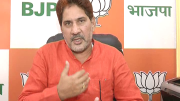With evolving times, many are questioning society’s need to protect women, especially on days like Raksha Bandhan, when they can very well do it themselves, like Chandigarh’s Varnika Kundu.
Varnika Kundu, a disc jockey and daughter of a senior IAS officer, who was allegedly harassed and stalked by Haryana BJP president Subhash Barala’s son Vikas Barala and his friend, was alert and called the police immediately, leading to their arrest.
However, the accused, booked on bailable charges, were granted bail soon after. The Chandigarh police reportedly dropped three serious charges against Vikas Barala and his friend in the stalking case.
The police registered the FIR under IPC Sections 354 D (stalking) and Section 185 of the Motor Vehicle Act. They reportedly dropped Sections 341 (punishment for wrongful restraint), 365 (kidnapping or abducting with intent secretly and wrongfully confine person) and 511 (punishment for attempting to commit offences punishable with imprisonment for life or other imprisonment) from the FIR registered against Haryana BJP chief’s son and his friend.
LOW CONVICTION RATE
Varnika Kundu’s father said, “As a father of two daughters, I feel compelled to take this matter to its logical conclusion. The goons must be punished, and the law must take its course.”
Yet, a look at recent figures show that nearly 11 lakh cases of crimes against women were pending for trial by the end of 2015.
According to National Crime Records Bureau (NCRB) figures for 2015, 27,844 cases ended in conviction during the year–at a conviction rate of 21.7 per cent.
The NCRB figures for 2011-2015 show a spike in number of rape cases registered in 2013-2015. Against 24,206 cases of rape registered against women in 2011, the number went up to 36,735 in 2014 and 34,651 in 2015.
Cases of kidnapping and abduction of women have also corresponding gone up, from 35,565 in 2011 to 59,277 in 2015. In 2015, 6,266 cases of stalking (under Section 354D of the IPC) were reported across the country.
The NCRB data notes that while chargesheets were submitted in all cases of custodial gang-rape, low chargesheet rate, 70.4 per cent, was seen in cases of kidnapping and abduction of women.
REFORMS IN PIPELINE
The NCRB figures are probably just the tip of the iceberg, considering many cases of crimes against women still go unreported.
According to The World’s Women 2015, a study by United Nations, less than 40 per cent of the women who experience violence of any kind seek help, and of them only 10 per cent seek help from police.
Women make up for less than 35 per cent of police personnel in countries that are trying to collect data on violence against women.
In the aftermath of the Nirbhaya rape case, the Justice Verma Committee report listed out a slew of reforms needed for managing cases of crimes against women.
These included police training on dealing with sexual offences appropriately and increasing number of female police personnel on patrol and at police stations so that “females feel comfortable in complaining of sexual harassment or threats of a sexual nature” to the police.
Lack of gender-sensitising measures and not having enough women police personnel on board to record cases of crimes against women are some of the issues that continue to vex the Indian system.
According to an IndiaSpend report of August 2016, women constitute 6.4 per cent of the police force across the country.
The police reforms are surely coming about, but many may argue that pace is not satisfactory. In such a scenario, it is a long way before India can claim to be safe for women.





Be the first to comment on "Haryana stalking, Raksha Bandhan and the recurring question of women’s safety in India"